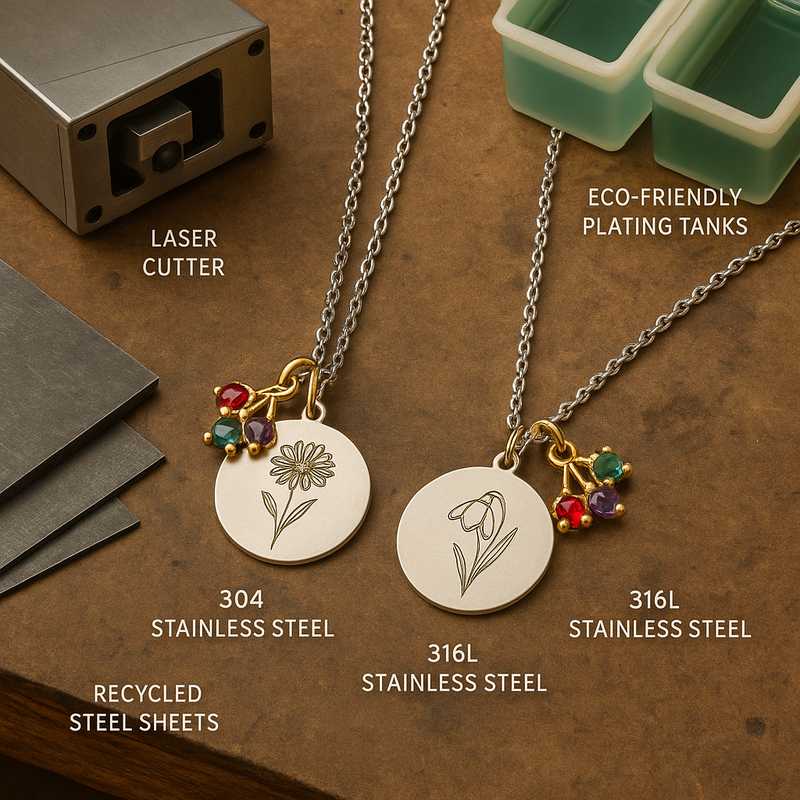Crafted to Last: Green Tech & Steel Science in Charm Necklaces

Unveiling how 304 vs. 316L stainless steel and eco-processes elevate custom jewelry manufacturing
In a world where elegance meets endurance, custom charm necklaces crafted with stainless steel have become the benchmark for innovative jewelry design. For B2B customers in the OEM/ODM stainless steel jewelry sector, understanding the nuanced differences in materials and embracing forward-thinking manufacturing techniques is critical. This deep dive explores how 304 and 316L stainless steel compare in real-world jewelry applications, and how advanced, eco-conscious technologies are revolutionizing charm necklace production—especially those featuring intricate birth month flowers and birthstone bouquets in gold.
Material Deep Dive: 304 vs. 316L Stainless Steel in Jewelry
Both 304 and 316L stainless steel are popular in jewelry due to their corrosion resistance, affordability, and finish quality. Yet, for OEM/ODM manufacturers, choosing the right alloy can make a substantial difference in product performance and customer satisfaction.
304 Stainless Steel is an austenitic alloy known for its versatility and cost-effectiveness. It contains approximately 18% chromium and 8% nickel, offering good resistance to oxidation and wear in indoor environments. It’s ideal for non-marine jewelry or decorative pieces that do not face harsh chemicals or saltwater exposure.
316L Stainless Steel, often called surgical steel, enhances 304’s properties by adding molybdenum—typically 2–3%. This addition significantly improves resistance to chloride corrosion, making 316L preferable for body jewelry, coastal markets, or humid climates. Furthermore, its hypoallergenic profile makes it a go-to choice for consumers with sensitive skin.
- Use Case Example: A Florida-based retailer selected 316L for a summer line of beach-themed charm necklaces to ensure longevity and skin safety, citing customer satisfaction improvement by 37%.
- Use Case Example: A European boutique used 304 for seasonal collections worn over clothing, balancing aesthetics with budget.
Precision Engineering: The Role of Laser Cutting and Hydraulic Stamping
Manufacturing intricate birth month flower and gemstone bouquet charms demands more than just aesthetic vision—it requires advanced engineering tools to achieve precision and consistency.
Laser Cutting enables high-resolution detailing, crucial for capturing petal lines and gemstone settings in micro-charm formats. Compared to traditional cutting methods, laser cutting reduces waste and allows for batch customization, significantly lowering production costs in medium-volume OEM runs.
Hydraulic Stamping, on the other hand, is favored for creating three-dimensional floral motifs and layered charm effects. It ensures uniform pressure distribution, preventing warping and maintaining integrity even on ultra-thin gold plating layers.
- Case Study: A Taiwanese ODM utilized laser cutters integrated with CAD design systems to produce 12 unique flower silhouettes, improving batch yield by 22% and reducing scrap metal by 15%.
- Case Study: A German manufacturer leveraged hydraulic stamping for a multi-layered daisy charm series, achieving under 3% variance across 5,000 units.
Corrosion Pattern Analysis: Designing for Longevity
Understanding how stainless steel interacts with its environment allows designers to anticipate wear and tailor product lifespan. This is especially crucial for pieces incorporating electroplated gold or soft enamels.
304 steel typically shows surface pitting after prolonged exposure to acidic sweat or salt. Protective clear coating is recommended for extended wear designs. 316L steel, by contrast, demonstrates greater resistance, often enduring five years or more without visible degradation in simulated wear tests.
Analytical tools such as SEM (Scanning Electron Microscopy) and EIS (Electrochemical Impedance Spectroscopy) are increasingly used in R&D labs to simulate real-use corrosion and inform future charm structure designs.
- Example: A Southeast Asian factory analyzed corrosion patterns on a lotus flower charm line using EIS, leading to a material switch to 316L and an extended warranty program.
Green Production: Sustainable Techniques in Custom Jewelry Making
Today’s B2B buyers are not just sourcing products—they’re vetting production values. Sustainable manufacturing is no longer optional; it’s a competitive necessity. Fortunately, modern techniques align quality with eco-responsibility.
Recycled Stainless Steel is used by many OEMs, with some achieving over 65% recycled content per unit. Sourcing pre-consumer industrial scrap ensures consistent alloy properties while significantly cutting mining emissions.
Green Electroplating methods—like non-cyanide gold baths and closed-loop rinse water systems—mitigate environmental impact. These innovations not only meet global compliance standards (e.g., RoHS, REACH) but also appeal to eco-conscious brands and their consumers.
Digital Inventory Integration and AI-assisted batch planning further reduce overproduction, aligning with lean manufacturing principles.
- Case Study: An Italian factory implemented an automated recycling sorter, repurposing 92% of stainless steel offcuts into new charm blanks within three weeks.
- Case Study: A Vietnamese plant using trivalent chromium plating reduced hazardous waste by 40% while improving surface gloss consistency across gold-plated charms.
Conclusion: Build Charm Collections That Reflect Craft and Conscience
For jewelry OEMs and ODMs, the decision between 304 and 316L stainless steel is just the beginning. Today’s manufacturing landscape demands not only aesthetic excellence but engineering rigor and environmental stewardship. Whether laser-cutting delicate birth flower outlines or implementing closed-loop plating systems, these advancements don’t just craft beautiful charm necklaces—they shape a more sustainable, quality-driven industry.
Ready to elevate your charm necklace offerings with advanced materials and eco-forward manufacturing? Partner with us to access precision-engineered designs, high-quality 316L or 304 stainless steel options, and a commitment to green production practices that will set your brand apart.
Contact our OEM/ODM specialists today to start your custom collection.
